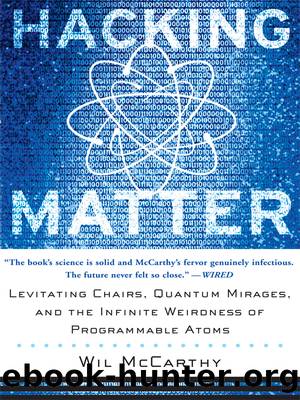Hacking Matter by Wil Mccarthy

Author:Wil Mccarthy [WIL MCCARTHY]
Language: eng
Format: epub
Publisher: Basic Books
Published: 2011-12-24T16:00:00+00:00
Superstrong Materials?
Covalent bonds between quantum dots are weak, but with more electrons to share than natural atoms, and many more ways to share them, it seems that we should be able to form not just double or triple bonds but massively parallel ones. If a hundred electrons were shared, wouldn’t that make the bond a hundred times stronger? And with van der Waals forces creating interdot bonds much stronger than any covalent bond, natural or otherwise, shouldn’t colloidal materials be much stronger than atomic ones? Alas, the answers are no, and no.
Sharing large numbers of electrons means storing large numbers of electrons, which means filling up all the low-order electron shells and branching out into vast, low-energy orbitals that are not at all tightly bound. Tug on the electrons with a chemical attraction, and they will simply pull free. They’re like broken Lego bricks—they’ll stay where you put them, but they can’t really grip. Any disturbance will knock them apart. As in nature, the strongest covalent bond you can form is probably a triple sharing of the electrons in the 2p orbital.
Still, that 2eV van der Waals bond looks pretty impressive. Random thermal energy certainly isn’t going to break it, so we can guess—correctly— that buckyball crystals should be stable at room temperature and above. But we’ve already seen Bawendi’s colloidal materials, which are held together exclusively by these bonds, and they are by no means superstrong. Quite the reverse, they’re extremely brittle and easily scratched, even though the CdSe semiconductor they’re made from is rather tough. Where does this discrepancy come from?
Because real atoms are smaller than artificial ones, they’re also closer together. Atomic crystals are densely packed, and so are the bonds between the atoms. Diamond is made of 5eV covalent bonds, and a 10 nm sphere of it contains over three thousand of them, oriented in a variety of directions. You wouldn’t need to break all of these bonds in order to destroy the crystal, but you would need to break all the ones that pass through one particular plane of cleavage. This would tear (or shear) one half of the sphere away from the other half, which is exactly what a diamond cutter does when shaping jewels. How much energy would this take? About 500 electron-volts, give or take. Contrast this with the ~2 eV required to pry apart two spheres of the same size joined by van der Waals forces, and you quickly see why it’s easier to separate colloidal dots than it is to break them.
Moreover, since the cross-sectional area of a crystal grows as the square of its diameter, this effect scales enormously with size. If we have a film of Bawendi dots that is 30 nanometers thick and 1 million nanometers (or 1 millimeter) wide, cracking it requires only the breaking of 300,000 van der Waals bonds. Cracking a diamond film of the same dimensions requires the breaking of billions of covalent bonds, using thousands of times more energy. This is why diamond films make great, durable coatings for tools, while colloidal films do not.
Download
This site does not store any files on its server. We only index and link to content provided by other sites. Please contact the content providers to delete copyright contents if any and email us, we'll remove relevant links or contents immediately.
Sass and Compass in Action by Wynn Netherland Nathan Weizenbaum Chris Eppstein Brandon Mathis(7782)
Grails in Action by Glen Smith Peter Ledbrook(7697)
Configuring Windows Server Hybrid Advanced Services Exam Ref AZ-801 by Chris Gill(6568)
Azure Containers Explained by Wesley Haakman & Richard Hooper(6558)
Running Windows Containers on AWS by Marcio Morales(6087)
Kotlin in Action by Dmitry Jemerov(5066)
Microsoft 365 Identity and Services Exam Guide MS-100 by Aaron Guilmette(4918)
Combating Crime on the Dark Web by Nearchos Nearchou(4499)
Management Strategies for the Cloud Revolution: How Cloud Computing Is Transforming Business and Why You Can't Afford to Be Left Behind by Charles Babcock(4414)
Microsoft Cybersecurity Architect Exam Ref SC-100 by Dwayne Natwick(4341)
The Ruby Workshop by Akshat Paul Peter Philips Dániel Szabó and Cheyne Wallace(4174)
The Age of Surveillance Capitalism by Shoshana Zuboff(3955)
Python for Security and Networking - Third Edition by José Manuel Ortega(3741)
Learn Windows PowerShell in a Month of Lunches by Don Jones(3509)
The Ultimate Docker Container Book by Schenker Gabriel N.;(3408)
Mastering Python for Networking and Security by José Manuel Ortega(3344)
Mastering Azure Security by Mustafa Toroman and Tom Janetscheck(3330)
Blockchain Basics by Daniel Drescher(3294)
Learn Wireshark by Lisa Bock(3263)
